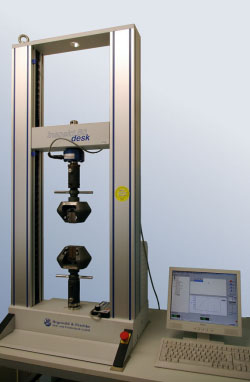10 Tips to Help You Choose the Perfect Universal Testing System
Choosing the right testing machine can help lower costs and accelerate product development. Whether company is buying its first testing system or is looking for a different type of system to perform tests on a new product, purchasing a testing system is an important decision. We’ve put together 10 easy steps to help you select the perfect system for your testing application.
1.Determine the mechanical property(s) you need to measure. Most tension, compression, flexure, and peel tests can be performed with traditional universal testing machines. Torsion, biaxial, and fatigue tests usually require systems designed specifically for those types of tests.
2.Determine the maximum load required to perform your tests. Your maximum load capacity will determine the type of frame that you need (table-top vs. floor-standing, single vs. dual column, electromechanical vs. hydraulic).
 3.Determine the maximum speed required to perform your tests. When performing static tests, there is usually an inverse relationship between how fast a system can perform a test and its maximum load capacity. When performing fatigue tests, the testing system is generally equipped with a different type of actuator, drive, and motor that will allow large or small capacities to perform at the same high speed.
3.Determine the maximum speed required to perform your tests. When performing static tests, there is usually an inverse relationship between how fast a system can perform a test and its maximum load capacity. When performing fatigue tests, the testing system is generally equipped with a different type of actuator, drive, and motor that will allow large or small capacities to perform at the same high speed.
4.Choosing grips/fixtures. Fixtures should provide a secure hold and be relatively easy to load while not damaging the specimen. Versatility is also another important consideration. While thread fixtures will help properly align samples, they limited to only one type of specimen (thread). On the other hand, a vice grip that might take longer to load can hold a variety of specimens.
5.Determine your data analysis and calculation needs. Virtually all testing systems are capable of displaying and saving peak load data. Some more advanced testing systems offer built-in ASTM/ISO testing analyses as well as the ability to display real-time graphs and perform advanced calculations.
6.Determine your data reporting and presentation needs. Simple quality control testing on a manufacturing floor might not require, or provide time for, in-depth reporting. Conversely, a research laboratory will probably want a system capable of generating detailed test reports that show specimen details, calculations, and graphical analyses.
7.Determine the need for an extensometer or deflectometer. While most testing systems are capable of measuring elongation and displacement based on grip separation, using an extensometer or a deflectometer can provide more accurate results.
8.Determine if you need a temperature chamber or bath. If you want to measure the mechanical properties of samples under specific environmental conditions, you will need a system equipped with a temperature chamber or liquid bath.
9.Evaluate the limitations of your testing area. Small research laboratories probably prefer compact and quiet table-top electromechanical machines while large manufacturing floors are more likely to be able to accommodate larger hydraulic or floor-standing systems.
10.Plan for the future. If you choose a system that is limited in terms of load capacity, speed or test types that it can perform, you might have to purchase an entirely different system for a future application. Choosing a system that satisfies all your current requirements and is versatile enough to be used for different types of products or tests could provide significant long-term savings.





